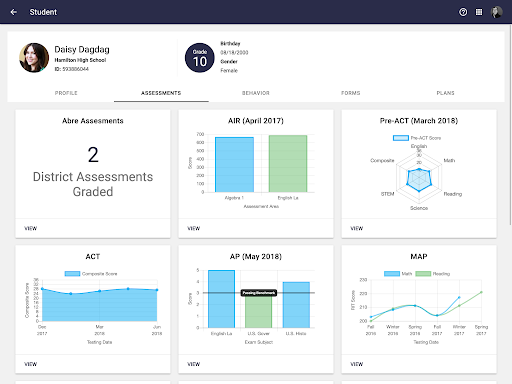The edtech landscape has shifted. Again. In the past month, two titans in the game, PowerSchool and Instructure, have rung the bell on Wall Street with the recent announcement of their IPOs. The latter of which is known in K-12 more for its ubiquitous and genre-influencing learning management system, Canvas, used by a significant number of Indiana school districts since their marketing firmly established them in the space in the past decade. The pandemic’s sequel will continue to reinforce their market dominance. This isn’t typical talk for edleaders—whether or not the vendors they support are publicly traded. But as alluded to in the introduction of the series, there are factors to be considered that should impact our decision making as we steward flush technology budgets and negotiate contracts. In addition to many technology-related questions we can ask as we evaluate, one other question we could ask ourselves:
Are your property tax dollars in edtech being funneled towards shareholders or stakeholders?
Not to incite a slippery slope argument here as you evaluate for-profit architecture or construction companies building a new elementary school or converting a building into a STEM academy, but this change in how edtech companies prioritize whom they serve needs to be a consideration. This is because every product we evaluate has a natural life cycle. It behooves us to catch products on the rise vs. those that have flattened out in their development as established brands, often with a venture equity firm or IPO holding more control over the product roadmap than the genius that led to the solution’s inception and early successes. And whether or not an edtech solution started with some pioneering and digitally-savvy educators trying to solve a local problem, most for-profit edtech startups and younger companies serving K-12 may eventually head towards the same route if their solution takes off, but until they do, there’s one key advantage: they serve the users of their products above any other cohort. This means that educators and the families affected by their work get more say in how the product roadmap matures which means more relevance in the immediate and near future. Cincinnati-area startup Abre.io is one such company that has made innovation appear simple. The company started when founders Zach Vander Veen and Chris Rose, then from Hamilton City Schools, realized they could start to develop a solution that covered the deficiencies of their district’s edtech stack. In Ohio, like other states, a local and long-in-the-tooth student information system that started as a homegrown piece of software in a prior technological era was showing its edges and not keeping up with the needs of a modern school district. Vander Veen and Rose couldn’t wait longer for a current product roadmap from their vendor, so they built the features they needed and started to use them with their own work, serving the needs of 10,000 students. Their initial beta saved the district $450,000 in its first year by replacing numerous tools and workarounds that accommodated their aging SIS. Now, they’re helping many other districts accomplish similar results and more. Currently, the team is showcasing their SEL solution, the latest in high-quality features demanded by educators. And since Abre is designed by educators, it’s no surprise that they’re becoming more and more successful in supporting the work of Indiana educators.
Showcase Focus 1: Abre

Abre, Spanish for “open,” was founded by two Ohio educators who had grown weary of the lack of development from their plethora of EdTech vendors. They spotted gaps in their SIS provider’s feature set which were not going to be addressed by the product roadmap, saw an opportunity and decided to build the solution, a platform of complementary apps that now applies to serving any modern school. They chose the name to reflect the company’s value of keeping the architecture of the platform open and extensible, not only for forthcoming Abre apps, but for all the third-party tools that are already serving users well. Where Abre shows value is in how it brings together the relevant information, data, and people for making insight obvious. Through beautifully designed UX/UI and efficiencies, Abre removes the guesswork about how to support a child between different roles in our learning communities and even extends learning beyond the bell schedule and classroom walls. This is because Abre is in a class unto itself, picking up the edges of our other platforms and actually unifying them, unlike what many of the bigger companies out there advertise. Interoperability, single sign-on, data visualization, and specialty tools that simply don’t exist in our edtech ecosystem (but you wonder how you lived with that overpopulated, complicated spreadsheet so long when you see Abre). What it means is less confusion and disruption for students and parents, let alone school staff and those involved with extracurriculars or off-campus learning. Administrators get the luxury of more accurate and precise data as well as the decisions that data informs. All secure and modern in both the front-end experience and the backend performance. Abre’s platform can complement or improve a district’s tech stack. Seamless integrations with your current systems such as a school’s SIS and other data stores, often in real-time (instead of nightly syncs) using the application programming interface (API) approach to data interoperability. The flexibility of the platform allows all stakeholders to focus on serving the learner’s discrete needs in one of six current categories:
- School Management
- Learning Management
- Career & Technical Education
- Community Engagement
- Professional Learning
- Social Emotional Wellbeing
District leaders report that Abre was the solution they have been trying to build over the last decade. They have recovered lost productivity and have sharpened the efficacy of their interventions. Users have secure access to target information and meaningful and usable data based upon their role in the school, district, or learning community at large. What makes Abre pass muster technologically are their adherence to open standards as a Software as a Service (SaaS) product, their empathetic approach to developing an intuitive user interface, and a bedrock commitment to data interoperability so that all apps securely exchange salient data. Since Abre brings together the learning community, it’s a difference-maker to learning communities returning for the ‘21-’22 school year, complementing your revised plan for flexible learning and empowering your stakeholders to truly know a child and how to help. Their recent release of comprehensive SEL support is timely as another school year starts with an unsteady forecast for eliminating the disruptions that have become the new normal. Coupled with other recent features for their Community Engagement and Career & Technical Education management features, Abre brings overall integration to the modular quality of school data and fills in gaps in such a robust manner that it extends the overall performance of any edtech stack to serve all users equitably. Looking ahead to future posts, what hidden gems have you found to help your practice? Be sure to leave your thoughts on Twitter: @KeepINLearning @ericnentrup.
Resources
Please login or register to claim PGPs.
Alternatively, you may use the PGP Request Form if you prefer to not register an account.



